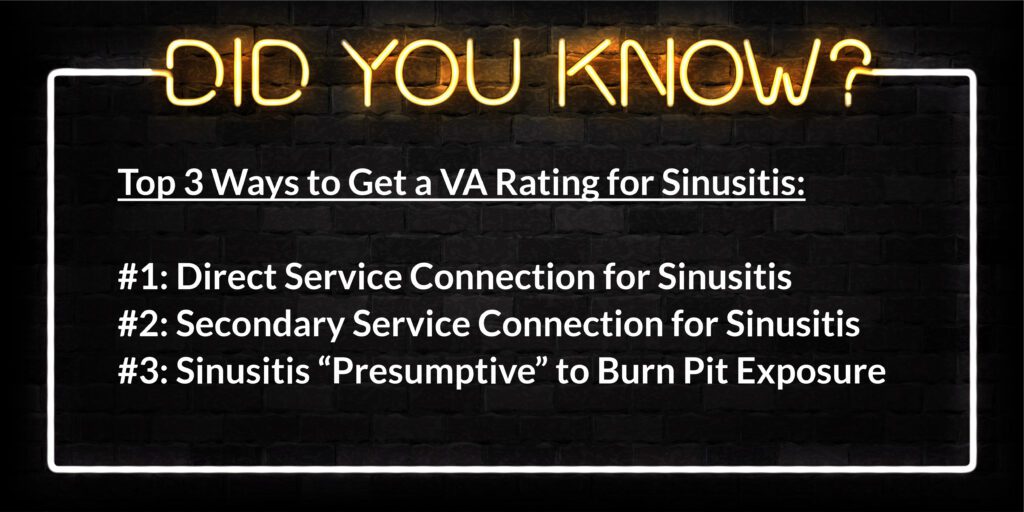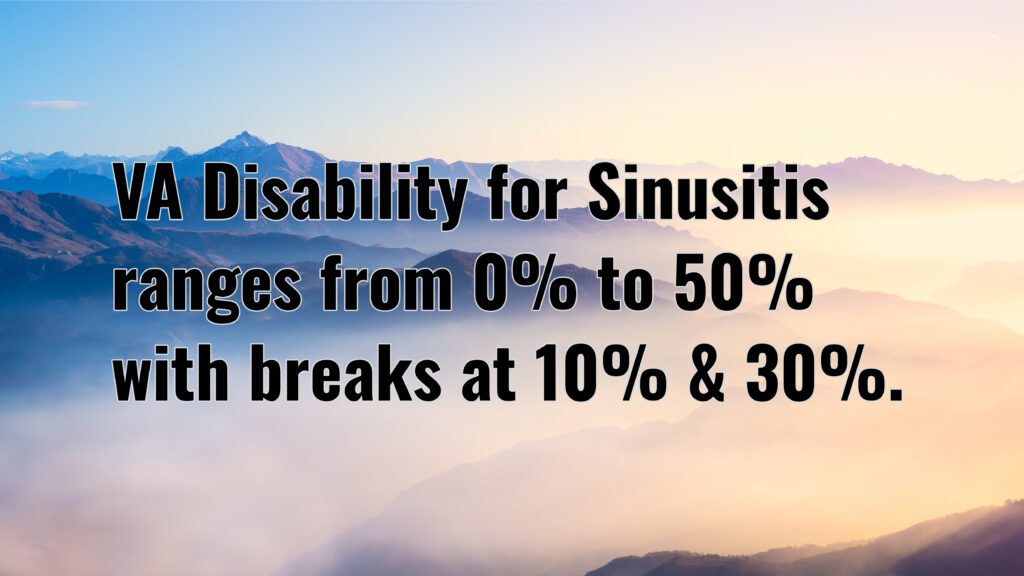Looking for Expert-Level VA Claim Answers?📱Call Us Now! 737-295-2226
If you’re a veteran struggling with chronic sinus problems, understanding how the VA assigns a sinusitis VA rating is key to getting the benefits you deserve.
VA disability ratings for sinusitis range from 0% to 50%, depending on the frequency, severity, and duration of your symptoms.
The highest possible rating is 50%, which applies when sinusitis is near constant with headaches, pain, tenderness, and discharge, or after radical surgery with chronic bone infection. Your final rating depends on how much sinusitis affects your daily life, work, and overall health.
It’s important to note that the VA only rates chronic sinusitis—not acute sinusitis. Veterans with chronic sinusitis may also be at higher risk for conditions like obstructive sleep apnea, which can sometimes be rated as a secondary service connection.
Let’s break down exactly how sinusitis is defined, how it’s rated, and what steps to take if you want to file or increase your claim.
Table of Contents
Summary of Key Points
- Sinusitis VA ratings range from 0% to 50%, depending on the frequency, severity, and duration of symptoms and required treatments.
- Only chronic sinusitis is eligible for VA disability benefits; acute sinusitis is not rated.
- Veterans exposed to burn pits in Southwest Asia or Afghanistan may qualify under presumptive service connection.
- Common secondary conditions linked to sinusitis include allergic rhinitis, deviated septum, asthma, and sleep apnea.
What is Sinusitis in Veterans?
In simple terms, Sinusitis is a sinus infection.
If you get sinus infections often and for a sustained period, they’re considered “chronic.”
Chronic Sinusitis, also called “Chronic Rhinosinusitis,” arises when the spaces on the inside of your nose and head become swollen and inflamed for three months or longer, regardless of medical treatment.
Chronic Sinusitis is a common condition in veterans, especially those exposed to burn pits; it interferes with the way mucus drains, leaving you with a stuffy nose.
Thus, breathing through your nose might be difficult, and the area around your eyes could be swollen or tender.
Chronic Sinusitis can come about from an infection, nasal polyps, or swelling of the inner lining of your sinuses.
There are two primary types of Sinusitis:
- Acute Sinusitis usually lasts between 7-10 days and is mostly caused by the common cold. Acute Sinusitis causes your sinuses to become inflamed and swollen.
- Chronic Sinusitis lasts for more than 3 months, even with medical treatment. Chronic Sinusitis has the same symptoms as Acute Sinusitis, except that the former lasts longer and doesn’t usually respond to medical treatment.
Common Signs and Symptoms
According to the Mayo Clinic, symptoms of Sinusitis in veterans include:
- Nasal inflammation
- Runny nose with thick, discolored discharge
- Drainage down the back of the throat
- Stuffy nose, making it hard to breathe
- Pain, tenderness, or swelling around your eyes, cheeks, nose, or forehead
- Decreased sense of taste and smell
- Earaches
- Headaches
- Pain in the upper jaw and teeth
- Cough, to include throat-clearing
- Sore throat
- Bad breath
- Fatigue
Basic Eligibility Criteria
To be eligible for a Chronic Sinusitis VA Rating, a veteran must meet three (3) criteria by law:
- #1. Medical diagnosis of Chronic Sinusitis, in a medical record (Service Treatment Records, VA medical records, or private medical records)
- #2. Your Sinusitis was caused or made worse by your active-duty military service OR by another service-connected disability for secondary service connection (“Nexus” for service connection)
- #3. Persistent and recurring symptoms of Sinusitis (“Severity of Symptoms”) in terms of Frequency, Severity, and Duration to include any functional impacts.
If you think you have Chronic Sinusitis, but don’t have a medical diagnosis, pick up the phone and call the VA health facility nearest you to make an appointment right away!
If you’re trying to increase your VA rating for Sinusitis, you need to prove to the VA that your symptoms are now worse and warrant the higher rating criteria by law.
The #1 best way to increase your VA rating for Sinusitis is to have objective medical evidence to show your symptoms have worsened over time.
How Do I Get a Sinusitis VA Rating?

There are 3 primary ways a veteran can get a VA disability rating for Sinusitis (Chronic):
#1: Direct Service Connection for Sinusitis with a rating of 0%, 10%, 30%, or 50%. This means an in-service event, injury, or disease related to your military service caused you to develop Sinusitis.
#2: Secondary Service Connection for Sinusitis with a rating of 0%, 10%, 30%, or 50%. For example, a veteran can be rated for Sinusitis secondary to a Deviated Septum.

#3: Sinusitis “Presumptive” to Burn Pit Exposure with a rating of 0%, 10%, 30%, or 50%. If you served in the Gulf War region during the presumptive period, the VA assumes your Sinusitis is related to burn pits. The presumptive period for particulate matter exposure is Afghanistan, Djibouti, Syria, and Uzbekistan during the Persian Gulf War, from September 19, 2001, to the present, OR the Southwest Asia theater of operations from August 2, 1990, to the present. To be eligible for presumptive VA benefits, you must have developed Sinusitis within 10 years of your separation from active duty military service.
Sinusitis VA Ratings
Sinusitis VA ratings are 0%, 10%, 30%, or 50%, depending on the severity of your symptoms. The VA rates Sinusitis under CFR 38, Part 4, VA Schedule of Ratings, Diagnostic Code 6510, Sinusitis, Pansinusitis, Chronic.
However, your Sinusitis must be considered “Chronic” to be eligible for VA disability benefits.

- 50 Percent VA Rating: Following radical surgery with chronic osteomyelitis (bone infection), or near constant Sinusitis (sinus infections) characterized by headaches, pain and tenderness of the affected sinus, and purulent discharge or crusting after repeated surgeries.
- 30 Percent VA Rating: Three or more incapacitating episodes per year of Sinusitis requiring prolonged (lasting four to six weeks) antibiotic treatment, or more than six non-incapacitating episodes per year of Sinusitis characterized by headaches, pain, and purulent discharge or crusting.
- 10 Percent VA Rating: One or two incapacitating episodes per year of Sinusitis requiring prolonged (lasting four to six weeks) antibiotic treatment, or three to six non-incapacitating episodes per year of Sinusitis characterized by headaches, pain, and purulent discharge or crusting.
- 0 Percent VA Rating: Detected by X-ray only. No other symptoms.
Note: An “incapacitating episode” of Sinusitis means you require bed rest and treatment by a physician.
Pro Tip: Were you exposed to Burn Pits? If you served in Afghanistan, Southwest Asia or certain other regions and developed sinusitis, rhinitis, rhinosinusitis, or asthma within 10 years from your separation from active duty service, these respiratory conditions are presumed to be service-connected. This is especially big news for Afghan war veterans.
What is the Reasonable Doubt Rule for Sinusitis?
The reasonable doubt rule, also known as the Benefit of the Doubt Doctrine, means that the evidence provided by the veteran must only persuade the decision-maker that each factual matter is “at least as likely as not.”
This means there’s a 50/50 chance.
When, after careful consideration of all evidence, a reasonable doubt arises regarding service origin, the degree of disability, or any other point, such doubt will be resolved in favor of the veteran.
The courts further likened the reasonable doubt rule as akin to the principle in baseball that the “tie goes to the runner.”
When in doubt, the benefit is ALWAYS given to the veteran.
Independent providers and C&P examiners must consider and give weight to the veteran’s self-reported symptoms when completing their DBQ for Sinusitis.
What Should I Expect at a VA C&P Exam for Sinusitis?
During your VA Compensation & Pension (C&P) exam, the examiner will:
- Review your medical records to confirm a diagnosis of chronic sinusitis (acute cases are not rated).
- Ask about how often sinus episodes occur, their severity, and how they affect your daily life and work.
- Note symptoms like headaches, facial tenderness, nasal discharge, surgery history, and antibiotic treatment.
- Possibly order or review diagnostic imaging (like CT scans or X-rays) if none have been performed.
Pro Tip: Be clear and specific about which sinuses are affected (e.g., maxillary, frontal, ethmoid, sphenoid, pansinusitis) and describe your symptoms in terms of frequency, severity, and impact. Use medical terms when possible (e.g., purulent discharge, incapacitating episodes requiring prolonged antibiotics).
For a full checklist of what to expect and how to prepare, check out our C&P exam guide: VA C&P Exam for Sinusitis
What Are VA Secondary Conditions to Sinusitis?
It’s possible for your Sinusitis to be caused or made worse by another service-connected disability for secondary service connection.
Here’s a list of common VA secondary conditions to Sinusitis:
- Weakened immune system from other illnesses or medications taken to manage your service-connected disabilities.
Conclusion
Chronic sinusitis can be more than just a nuisance—it can significantly impact your breathing, daily functioning, and overall quality of life. The VA recognizes this, which is why a sinusitis VA rating can range from 0% to 50%, depending on your symptoms and treatment history.
To maximize your chances of approval, you’ll need strong medical evidence, a clear service connection, and an understanding of the VA’s rating criteria. Don’t forget that sinusitis can also lead to secondary conditions, such as sleep apnea or asthma, which may increase your total VA disability compensation.
If you’ve been denied before, or if your symptoms have worsened, you have the right to file again. With the right strategy and supporting evidence, you can get the benefits you earned.
Want Expert-Level Support for Your VA Disability Claim? WE GOT YOUR SIX!
- VA Claims Insider is the #1 most trusted name in VA disability claims.
- Work directly with a VA claims coach who can educate you to VA claim victory.
- 25,000+ disabled veterans have served in our membership programs since 2016.
- 30% average rating increase for veterans who complete our #1-rated Elite program.
- 4.7/5.0 average rating out of 5,500+ total reviews; over 4,500 5-star reviews.
FAQs
Is sinusitis a VA disability?
Yes. Chronic sinusitis is recognized as a VA disability and can be rated at 0%, 10%, 30%, or 50%, depending on how severe and persistent the symptoms are. Acute sinusitis, which typically resolves in 7–10 days, is not considered for disability benefits.
What is the highest VA rating for sinusitis?
The maximum schedular rating for sinusitis is 50%. This rating is assigned when the condition is near constant with severe symptoms such as chronic infections, frequent headaches, purulent discharge, or after repeated surgeries.
Can sinusitis be service-connected as a secondary condition?
Yes. Sinusitis can be rated secondary to other service-connected conditions, such as a deviated septum, allergic rhinitis, or asthma. Veterans can also pursue claims if sinusitis contributes to secondary conditions like obstructive sleep apnea.
What makes sinusitis “presumptive” for VA purposes?
Veterans who served in certain regions during the Gulf War era may qualify for presumptive service connection for sinusitis if they develop the condition within 10 years of leaving service. This applies to those exposed to burn pits and particulate matter in areas such as Afghanistan, Syria, Djibouti, Uzbekistan, and Southwest Asia.
About the Author

Brian Reese
Brian Reese is a world-renowned VA disability benefits expert and the #1 bestselling author of VA Claim Secrets and You Deserve It. Motivated by his own frustration with the VA claim process, Brian founded VA Claims Insider to help disabled veterans secure their VA disability compensation faster, regardless of their past struggles with the VA. Since 2013, he has positively impacted the lives of over 10 million military, veterans, and their families.
A former active-duty Air Force officer, Brian has extensive experience leading diverse teams in challenging international environments, including a combat tour in Afghanistan in 2011 supporting Operation ENDURING FREEDOM.
Brian is a Distinguished Graduate of Management from the United States Air Force Academy and earned his MBA from Oklahoma State University’s Spears School of Business, where he was a National Honor Scholar, ranking in the top 1% of his class.


